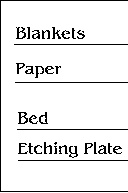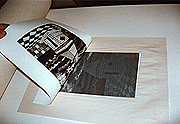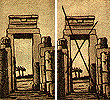  |
In order to obtain a print, a viscous greasy ink is pushed into the etched grooves, then the surface is wiped clean with muslin, leaving only the etched areas retaining ink. The actual impression is made with a copper plate press which is similar to an old washing mangle with a large plank or `bed’ between the rollers. The plate is placed on the bed, covered with dampened paper and backed with three or four felt blankets.
 |
 |
 |
These are then passed through the press under high pressure, the malleable paper is forced into the cuts and ridges in the plate and thus picks up the ink. When the paper is finally peeled off, it reveals a faithful mirror image of the etched drawing. This inking procedure is then repeated for each print.
LIMITED EDITION
When the etching is complete a limited number of prints are made. Then using a pencil the artist signs each print with the title, a signature and a fraction showing its position in the edition. For example 25/100 is the twenty fifth print out of an edition of one hundred. The artist is also allowed to make an extra 10% for personal use. Therefore, in an edition of one hundred, one hundred and ten prints are made. The extra ten are marked A/P (artists proof) instead of the fraction. They are valued above numbered prints by collectors because of their association with the artist.
 |
Finally, the plate is cancelled by scratching a line through the image. A print made from a scratched plate is called a ‘cancellation print’. It ensures that further prints cannot be made and the numbered impression can be trusted.
ORIGINAL PRINT
`Original’ prints are images made by the artist from beginning to end directly in or on the plate, stone, wood block & other matrix. Each print is a work of art, one of a limited edition and signed by the artist. The photo mechanical reproduction of paintings and drawings are often described as ‘Fine Art Prints’ but this term is misleading as they are not works of art, even if they have an artist’s signature.